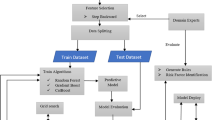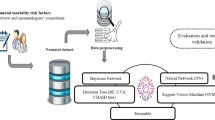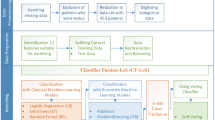Abstract
Neonatal mortality is a major concern in developing countries and is a crude indicator of the prevalence of poverty in a society. Neonatal risk analysis is an important decision-making tool for gauging progress and penetration of medical services in a specific region, especially in developing countries. This research compares the accuracy of the predictions of various machine learning algorithms and the impact of different sampling techniques, when attempting to classify neonatal mortality. We have conducted different rounds of experiments with six sampling techniques and seven machine learning algorithms on a neonatal death dataset. Further, groups of three base classifiers chosen among the seven machine learning algorithms were made into six different ensemble combinations and trained to improve the classification accuracy. The proposed diagnostic support system with an ensemble of random forest classifier, Gaussian NB, and AdaBoost with pipeline sampling achieved an accuracy and ROC AUC scores above 98% and 96%, respectively. This decision support tool will facilitate medical practitioner to identify infants at risk of dying before 28 days of life.
Access this chapter
Tax calculation will be finalised at checkout
Purchases are for personal use only
Similar content being viewed by others
References
UNICEF Homepage, https://data.unicef.org/, last accessed 2021/04/29
Sheth, P.D., Patil, S.T., Dhore, M.L.: Evolutionary computing for clinical dataset classification using a novel feature selection algorithm. J. King Saud Univ. Comput. Inf. Sci. 1–8 (2020)
Hsieh, M.H., Hsieh, M.J., Chen, C.M., Hsieh, C.C., Chao, C.M., Lai, C.C.: Comparison of machine learning models for the prediction of mortality of patients with unplanned extubation in intensive care units. Sci. Rep. 8, 1–7 (2018)
Neesha, J., Nur’Aini, A.R., Wahidah, H.: Data mining in healthcare—a review. Procedia Comput. Sci. 72, 306–313 (2015)
Seiffert, C., Khoshgoftaar, T., Van Hulse, J., Napolitano, A.: RUSBoost: a hybrid approach to alleviating class imbalance. IEEE Trans. Syst. Man Cybern. Part A Syst. Humans 40, 185–197 (2010)
Chawla, N.V., Bowyer, K.W., Hall, L.O., Kegelmeyer, W.P.: SMOTE: synthetic minority over-sampling technique. J. Artif. Intell. Res. 16, 321–357 (2002)
Yang, Z., Zoie, S.W., Kwok, L.T.: A framework of rebalancing imbalanced healthcare data for rare events’ classification: a case of look-alike sound-alike mix-up incident detection. J. Healthc. Eng. 1–11 (2018)
He, H., Bai, Y., Garcia, E.A., Li, S.: ADASYN: adaptive synthetic sampling approach for imbalanced learning. In: International Joint Conference on Neural Networks, pp. 1322–1328. IEEE, Hong Kong (2008)
Sheenal, P., Hardik, P.: Survey of data mining techniques used in healthcare domain. Int. J. Inf. Sci. Tech. 6(1), 53–60 (2016)
Pratyush, L., Sarthak, G., Taran, P.S., Madan, G.: Ensemble learning classification for medical diagnosis. In: International Conference on Computing, Communication and Security, vol. 6, pp. 1–5. IEEE, Patna (2020)
Author information
Authors and Affiliations
Corresponding author
Editor information
Editors and Affiliations
Rights and permissions
Copyright information
© 2022 The Author(s), under exclusive license to Springer Nature Singapore Pte Ltd.
About this paper
Cite this paper
Sivarajan, A., Bala Aditya, A., Sivasankar, E. (2022). Comparing the Predictive Accuracy of Machine Learning Algorithms for Neonatal Mortality Risk Classification. In: Gupta, D., Sambyo, K., Prasad, M., Agarwal, S. (eds) Advanced Machine Intelligence and Signal Processing. Lecture Notes in Electrical Engineering, vol 858. Springer, Singapore. https://doi.org/10.1007/978-981-19-0840-8_24
Download citation
DOI: https://doi.org/10.1007/978-981-19-0840-8_24
Published:
Publisher Name: Springer, Singapore
Print ISBN: 978-981-19-0839-2
Online ISBN: 978-981-19-0840-8
eBook Packages: Intelligent Technologies and RoboticsIntelligent Technologies and Robotics (R0)




